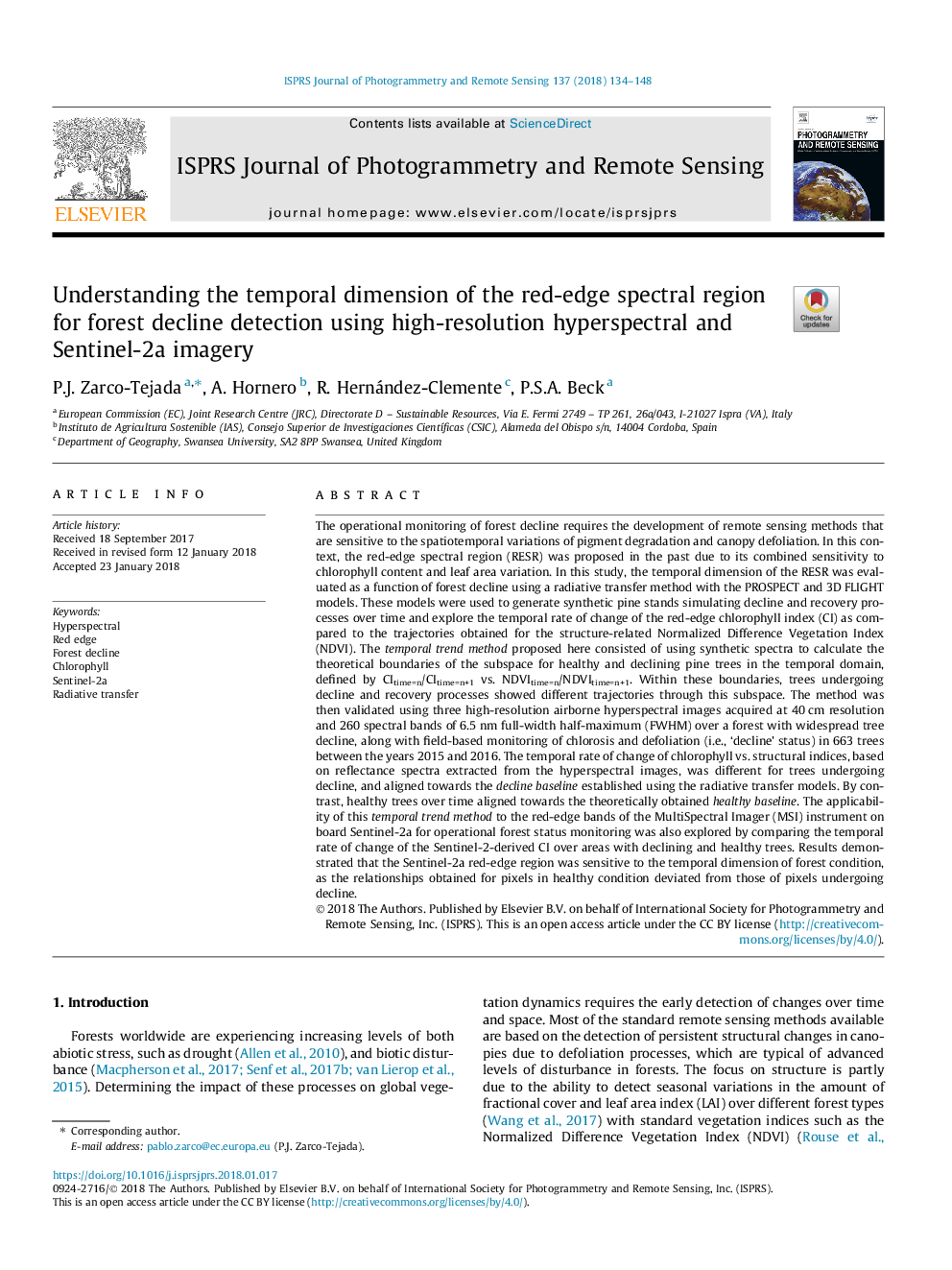| کد مقاله | کد نشریه | سال انتشار | مقاله انگلیسی | نسخه تمام متن |
|---|---|---|---|---|
| 6949230 | 1451237 | 2018 | 15 صفحه PDF | دانلود رایگان |
عنوان انگلیسی مقاله ISI
Understanding the temporal dimension of the red-edge spectral region for forest decline detection using high-resolution hyperspectral and Sentinel-2a imagery
دانلود مقاله + سفارش ترجمه
دانلود مقاله ISI انگلیسی
رایگان برای ایرانیان
کلمات کلیدی
موضوعات مرتبط
مهندسی و علوم پایه
مهندسی کامپیوتر
سیستم های اطلاعاتی
پیش نمایش صفحه اول مقاله

چکیده انگلیسی
The operational monitoring of forest decline requires the development of remote sensing methods that are sensitive to the spatiotemporal variations of pigment degradation and canopy defoliation. In this context, the red-edge spectral region (RESR) was proposed in the past due to its combined sensitivity to chlorophyll content and leaf area variation. In this study, the temporal dimension of the RESR was evaluated as a function of forest decline using a radiative transfer method with the PROSPECT and 3D FLIGHT models. These models were used to generate synthetic pine stands simulating decline and recovery processes over time and explore the temporal rate of change of the red-edge chlorophyll index (CI) as compared to the trajectories obtained for the structure-related Normalized Difference Vegetation Index (NDVI). The temporal trend method proposed here consisted of using synthetic spectra to calculate the theoretical boundaries of the subspace for healthy and declining pine trees in the temporal domain, defined by CItime=n/CItime=n+1 vs. NDVItime=n/NDVItime=n+1. Within these boundaries, trees undergoing decline and recovery processes showed different trajectories through this subspace. The method was then validated using three high-resolution airborne hyperspectral images acquired at 40â¯cm resolution and 260 spectral bands of 6.5â¯nm full-width half-maximum (FWHM) over a forest with widespread tree decline, along with field-based monitoring of chlorosis and defoliation (i.e., 'decline' status) in 663 trees between the years 2015 and 2016. The temporal rate of change of chlorophyll vs. structural indices, based on reflectance spectra extracted from the hyperspectral images, was different for trees undergoing decline, and aligned towards the decline baseline established using the radiative transfer models. By contrast, healthy trees over time aligned towards the theoretically obtained healthy baseline. The applicability of this temporal trend method to the red-edge bands of the MultiSpectral Imager (MSI) instrument on board Sentinel-2a for operational forest status monitoring was also explored by comparing the temporal rate of change of the Sentinel-2-derived CI over areas with declining and healthy trees. Results demonstrated that the Sentinel-2a red-edge region was sensitive to the temporal dimension of forest condition, as the relationships obtained for pixels in healthy condition deviated from those of pixels undergoing decline.
ناشر
Database: Elsevier - ScienceDirect (ساینس دایرکت)
Journal: ISPRS Journal of Photogrammetry and Remote Sensing - Volume 137, March 2018, Pages 134-148
Journal: ISPRS Journal of Photogrammetry and Remote Sensing - Volume 137, March 2018, Pages 134-148
نویسندگان
P.J. Zarco-Tejada, A. Hornero, R. Hernández-Clemente, P.S.A. Beck,